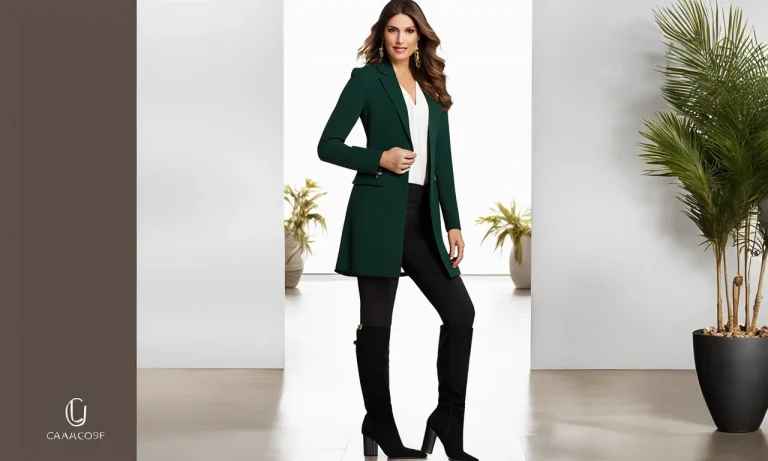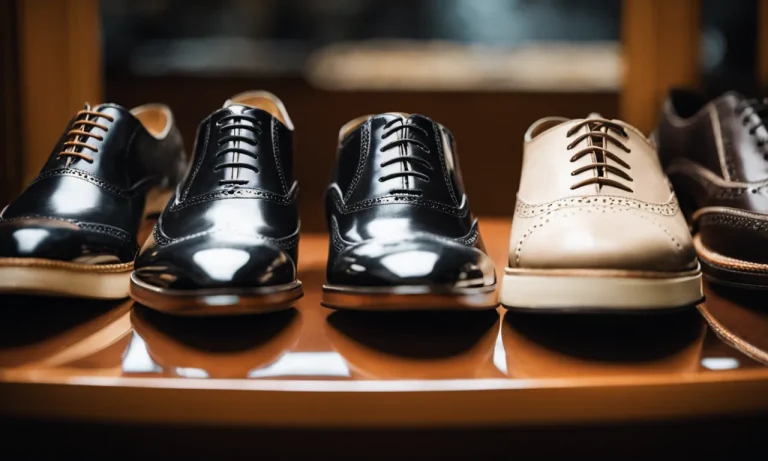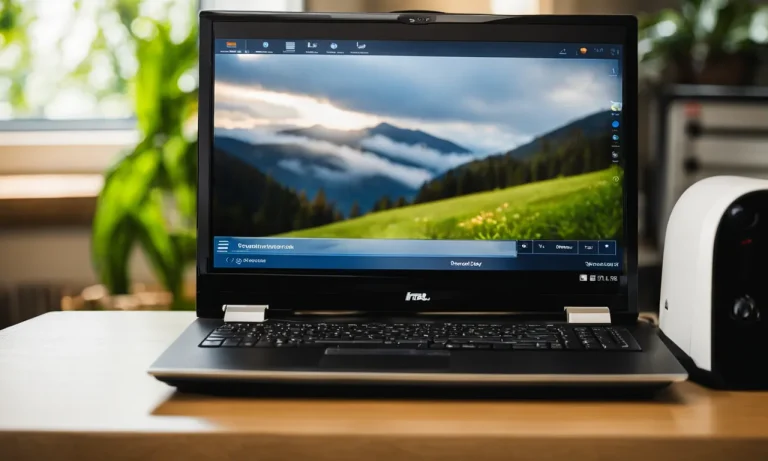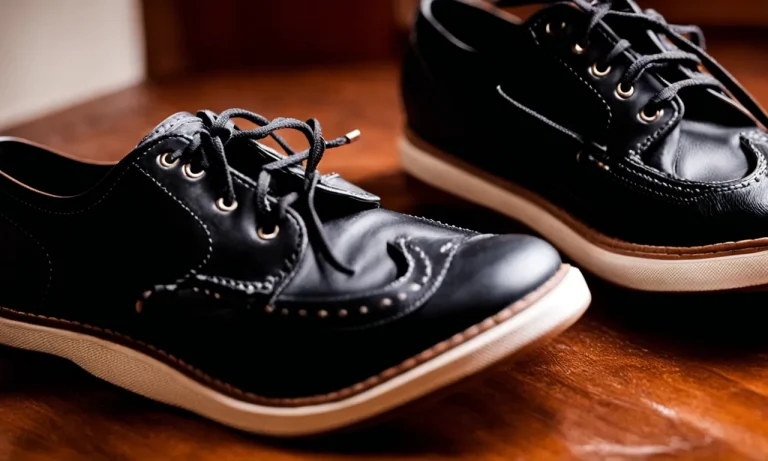Finding a perfectly fitted shoe can seem like an impossible quest. Your feet swell and change shape throughout the day, so there’s no such thing as one static shoe size. But whether you’re shopping online or in-store, understanding the keys to proper shoe fit will help you find footwear that offers the right amount of room in all the right places.
If you’re short on time, here’s the quick answer: For the best fit, shoes should have about a thumb’s width of space in the toebox, keep heels secure without slipping, and fasten snugly but not tightly around the instep and ankle.
In this comprehensive guide, we’ll cover everything you need to know to find shoes with the ideal fit for your feet and for the activity or purpose you’ll be wearing them for
Consider Your Feet and Activities
When it comes to finding the perfect fit for your shoes, it’s crucial to consider your feet and the activities you’ll be engaging in. Everyone’s feet are unique, and understanding your foot shape and any problem areas can help you find shoes that provide optimal comfort and support.
Foot Shape and Problem Areas
Feet come in various shapes and sizes, and it’s important to choose shoes that accommodate your specific foot shape. Some common foot shapes include flat feet, high arches, and wide feet. If you have flat feet, look for shoes with good arch support to prevent overpronation.
For those with high arches, shoes with cushioning and flexibility can help absorb shock and provide stability. If you have wide feet, opt for shoes with a wider toe box to avoid discomfort and blisters.
Additionally, it’s important to consider any problem areas you may have on your feet. Are there any bunions, corns, or calluses? These areas may require extra room or padding to ensure a comfortable fit.
If you have any foot conditions or concerns, consulting with a podiatrist can provide valuable insights into the best shoe options for you.
Athletic vs. Casual vs. Dress Shoes
The type of shoes you’ll be wearing will greatly impact the fit and comfort you require. Different activities and occasions call for different types of shoes, so it’s important to consider these factors when choosing the right fit.
Athletic shoes, such as running shoes or basketball shoes, should provide ample cushioning, support, and stability. They should also allow for proper toe movement and have a snug fit without being too tight.
Casual shoes, on the other hand, may offer more flexibility and a looser fit for everyday wear. Dress shoes, especially those with pointed toes or high heels, may require a more precise fit to avoid discomfort or pain.
Sock Thickness
When trying on shoes, it’s essential to consider the thickness of the socks you’ll be wearing with them. Different sock thicknesses can significantly affect the fit of your shoes. If you typically wear thicker socks, such as in colder months or for specific activities like hiking, try on shoes with those socks to ensure a proper fit.
On the other hand, if you often wear thinner socks or go sockless, test the shoes with that in mind.
Keep in mind that your feet can also change throughout the day due to swelling, so it’s recommended to try on shoes later in the day when your feet are at their largest. This will help ensure a comfortable fit regardless of any swelling that may occur.
Elements of Proper Shoe Fit
Toe room
One of the most important elements of proper shoe fit is having adequate toe room. A shoe should have enough space in the toe box for your toes to wiggle comfortably. It is recommended to have about a thumbnail’s length of space between your longest toe and the end of the shoe.
This allows for natural movement and prevents discomfort or pain. Tight-fitting shoes can lead to foot conditions such as bunions or hammertoes, so it’s essential to ensure proper toe room.
Heel fit
The fit of the heel is another crucial factor to consider when choosing shoes. The heel should fit snugly without slipping or rubbing against the back of your foot. A properly fitting shoe will cradle your heel and provide support, preventing blisters and irritation.
If your heel slips out of the shoe while walking, it may be a sign that the shoe is too big or not the right fit for your foot shape.
Instep snugness
The instep, or the top part of your foot where the shoe tongue sits, should feel snug but not overly tight. A shoe with proper instep snugness will provide support and prevent unnecessary movement inside the shoe.
If the instep is too tight, it can cause pressure points and discomfort, while a loose instep can lead to instability and potential injuries.
Length relative to feet
The length of the shoe in relation to your feet is crucial for a proper fit. Each person’s feet differ in size, so it’s essential to measure both feet and choose a shoe size that accommodates the larger foot.
It’s recommended to have about a half-inch of space between your longest toe and the end of the shoe. Remember that shoe sizes can vary between brands, so always try on shoes and walk around to ensure a comfortable fit.
Width
Having the right width is just as important as the length of the shoe. Shoes that are too narrow can cause discomfort, pinching, and even foot deformities. On the other hand, shoes that are too wide can lead to instability and blisters. It’s crucial to find a shoe that matches the width of your feet.
Many shoe brands offer different width options, so it’s worth exploring different sizes to find the perfect fit.
Tips for Trying on Shoes
Try shoes on at the end of the day
When it comes to finding the perfect fit, timing is everything. It’s recommended to try on shoes at the end of the day when your feet are slightly swollen. This will give you a more accurate representation of how the shoes will feel after a long day of walking.
By trying them on at this time, you can avoid purchasing shoes that may feel tight or uncomfortable later on.
Walk around the store
Don’t be afraid to take a little stroll around the store when trying on shoes. This will allow you to get a feel for how they fit and how they support your feet. You can pay attention to any areas where the shoes may be rubbing or causing discomfort.
Remember, a shoe that feels great when you’re sitting down may not necessarily be the best option for walking or standing for extended periods of time.
Consider inserts if needed
If you have specific foot conditions or require additional support, consider using inserts in your shoes. Inserts can help provide extra cushioning, arch support, or stability, depending on your needs. They can make a significant difference in the overall comfort and fit of your shoes.
It’s always a good idea to consult with a podiatrist or shoe specialist to determine the best type of inserts for your specific foot needs.
Don’t go by sizes alone
It’s important to remember that shoe sizes can vary between brands and styles. Instead of solely relying on the number on the shoe box, pay more attention to how the shoes actually fit on your feet. Don’t hesitate to try on a size up or down from your usual size to find the best fit.
Additionally, consider the width of the shoe, as some styles may be available in different widths to accommodate various foot shapes.
For more information on finding the perfect shoe fit, you can visit websites such as www.shoes.com or www.footwearetc.com which provide helpful guides and resources on shoe fitting.
Signs of Poor Fit and Remedies
Heel slipping
One of the common signs of a poor shoe fit is heel slipping. If your heel is constantly slipping out of the shoe, it can lead to discomfort and blisters. To remedy this issue, you can try using heel grips or inserts to provide a better fit and prevent slipping.
Additionally, make sure to choose shoes with a snug heel counter that provides proper support and stability.
Pressure points or blisters
Another indicator of a poor shoe fit is the development of pressure points or blisters. If you notice areas of your feet becoming painful or blistered after wearing certain shoes, it’s a clear sign that they are not fitting properly.
To alleviate this problem, consider using padding or moleskin on the affected areas to reduce friction and provide cushioning. Alternatively, opt for shoes that have a more spacious toe box to prevent any discomfort.
Toes hitting the end
If your toes are constantly hitting the end of your shoes, it indicates that the shoes are too small. This can cause pain, discomfort, and even lead to various foot issues. To resolve this problem, make sure to choose shoes that offer enough space for your toes to wiggle comfortably.
It is recommended to leave about a thumb’s width of space between your longest toe and the end of the shoe to ensure a proper fit.
Difficulty fastening
If you find it challenging to fasten or adjust the straps, laces, or buckles on your shoes, it may be a sign that the shoes are not the right fit for you. It is crucial to have shoes that are easy to put on and take off to ensure convenience and comfort.
Consider trying different closure types or shoe styles that better suit your needs and preferences.
Overly tight or loose
Lastly, if your shoes feel excessively tight or loose overall, it indicates an improper fit. Shoes that are too tight can cause pain, restrict blood flow, and lead to foot problems, while shoes that are too loose can lead to instability and discomfort.
It is essential to find shoes that provide a proper balance of snugness and flexibility. Try different sizes, widths, or styles until you find the perfect fit for your feet.
Remember, a shoe that fits well is crucial for your overall foot health and comfort. If you are unsure about your shoe size or fit, it is always recommended to consult with a professional shoe fitter or podiatrist for expert advice.
Special Considerations for Kids’ Shoes
When it comes to choosing shoes for kids, there are several special considerations to keep in mind. Children’s feet are still growing and developing, so it’s important to find shoes that provide the right fit and support.
Here are some key factors to consider when selecting shoes for your little ones:
Allow growing room
Kids’ feet can grow rapidly, so it’s crucial to choose shoes that allow for proper growth. Experts recommend leaving about a thumb’s width of space between the end of the longest toe and the tip of the shoe. This will provide sufficient room for growth without compromising comfort or stability.
Remember, children may not always communicate when their shoes feel tight, so it’s important to check the fit regularly.
Focus on proper width
In addition to length, it’s important to consider the width of your child’s feet. Shoes that are too narrow can cause discomfort and restrict proper foot development. On the other hand, shoes that are too wide can result in instability and potential tripping hazards.
Look for shoes that provide a good balance between length and width, ensuring a snug fit without constricting the foot.
Evaluate athletic shoes
When it comes to sports and physical activities, the right footwear is crucial for your child’s safety and performance. Athletic shoes should provide proper cushioning, traction, and support to prevent injuries.
Look for shoes specifically designed for the type of activity your child will be participating in, whether it’s running, soccer, or basketball. Consider consulting with a professional at a specialty sports store to ensure you choose the right pair.
Watch for signs of bad fit
It’s important to pay attention to any signs that indicate your child’s shoes may not be fitting properly. Look for redness, blisters, or calluses on the feet, as these can be indications of pressure points or rubbing.
Your child may also complain of discomfort, pain, or fatigue while wearing certain shoes. Regularly checking the fit and condition of your child’s shoes will help you identify any potential issues before they become problematic.
Remember, finding the right fit for your child’s shoes is crucial for their comfort, foot health, and overall well-being. Taking the time to consider these special considerations will ensure that your child is stepping out in shoes that support their growing feet.
Conclusion
Finding the perfect shoe fit requires trying on multiple sizes and styles, walking around the store, considering your foot issues, and keeping an eye out for pressure points. But taking the time to get the fit right pays off with shoes that are comfortable, supportive, and sized just right for your feet and activities.
With the tips above, you’ll be armed with the knowledge needed to find shoes that check every box for ideal fit.






